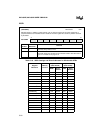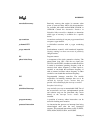
Glossary-1
GLOSSARY
This glossary defines acronyms, abbreviations, and terms that have special meaning in this man-
ual. (Chapter 1 discusses notational conventions and general terminology.)
1-Mbyte mode The addressing mode that allows code to reside
anywhere in the 1-Mbyte addressing space.
64-Kbyte mode The addressing mode that allows code to reside only
in page FFH.
accumulator A register or storage location that forms the result of
an arithmetic or logical operation.
The 80C196NU has enhanced multiplication instruc-
tions that use a new 32-bit accumulator for multiply-
accumulate operations.
ALU Arithmetic-logic unit. The part of the RALU that
processes arithmetic and logical operations.
assert The act of making a signal active (enabled). The
polarity (high or low) is defined by the signal name.
Active-low signals are designated by a pound symbol
(#) suffix; active-high signals have no suffix. To assert
RD# is to drive it low; to assert ALE is to drive it
high.
bit A binary digit.
BIT A single-bit operand that can take on the Boolean
values, “true” and “false.”
byte Any 8-bit unit of data.
BYTE An unsigned, 8-bit variable with values from 0
through 2
8
–1.
CCBs Chip configuration bytes. The chip configuration
registers (CCRs) are loaded with the contents of the
CCBs after a device reset.
CCRs Chip configuration registers. Registers that define the
environment in which the device will be operating.
The chip configuration registers are loaded with the
contents of the CCBs after a device reset.


















